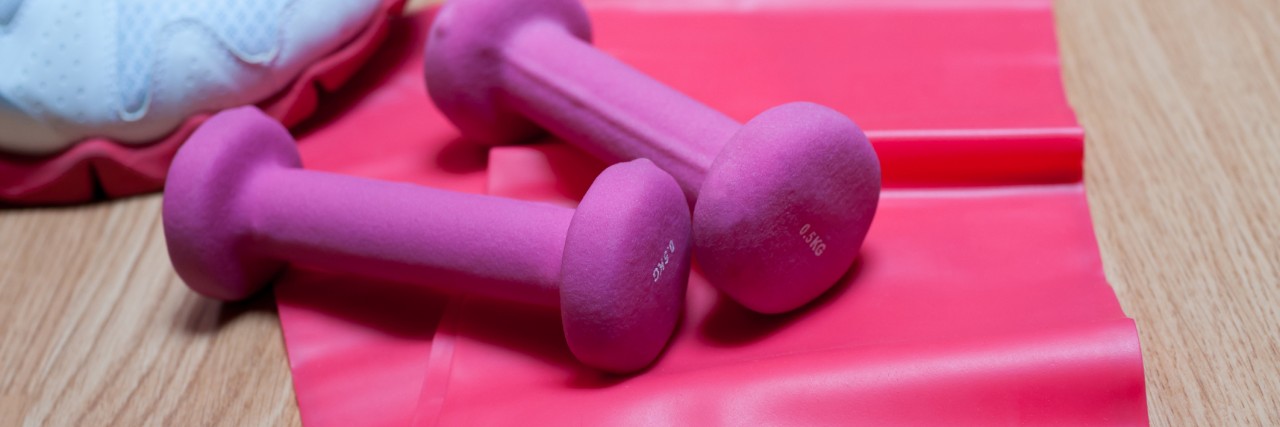Many years ago, in the days before my chronic health issues began, exercise and sports were a regular, much-enjoyed part of my life. There was nothing quite like racing down a field with a soccer ball at my feet, or clambering into a freezing lake with water skis strapped on, or standing at the top of a mountain I’d just hiked, looking out at what felt like the entire, beautiful world.
When health issues put an end to those sports I most loved, I still found a way to be active through long walks beside the little creek a few blocks from my home. It wasn’t the same, and I always felt the loss of the sports I loved, but at the same time, there was nothing quite like a jaunt through nature to get my heart pumping and set my world right. Many a night, after a hard stressful day, I’d slip on my sneakers and head down the front stairs, allowing the crisp Canadian air to fill my lungs and calm my soul as I walked around my neighborhood.
Then, suddenly, 11 months ago, I lost the ability to walk independently and had to accept a wheelchair into my life. (After several months, I’m at the point where I can use a walker inside my home now and a wheelchair elsewhere.) Gone were the long walks I loved so much; it created a cavernous hole in my life and heart.
After some moping, I decided enough was enough. Exercise has always been important to me, and if I had to be creative in how I exercised, so be it. The first thing I did was search the internet for ideas, but to my surprise it was hard to find ideas that worked for my specific situation. Many websites recommended exercises that were too intense for me. One showed a video of veteran soldiers doing heavy weightlifting in a gym and swinging on trapeze bars. Many others recommended playing wheelchair basketball, which I assume requires the ability to self-propel one’s wheelchair and handle fast wheelchair movements, both of which I cannot do. Other websites suggested going to a pool, but at this point in my life I am unable to drive on my own or to get my wheelchair out of my house without a strong adult taking me out, so that too was nixed.
Having been a physical therapist many years ago, I decided the best course of action would be to creatively design exercises that worked for my situation and my body. After a bit of trial and error, I came up with several exercises I love to do, all of which I do safely in a supported sitting position. A big key for me has been to listen to the messages my body sends me. My personality likes to push beyond my limits, but that not only leaves me discouraged, it risks injury. By working at my own pace, I am acting lovingly towards my body.
I thought I’d share some of my ideas here on The Mighty for others looking for exercise suggestions and tips.
Please note: always ask your physician or physical therapist prior to beginning any exercise program, and never push beyond what you can safely do for any exercises.
1. Dancing to music. I get my body supported in the way it needs to be comfortable, crank up the tunes (I recently discovered early rock-and-roll greats such as Buddy Holly and Ritchie Valens, which have a good beat) and start flailing my good leg, swinging my arms, and moving my back to the music. As an added benefit, the songs get stuck in my head, bringing a smile to my face throughout the day.
2. Exercise resistance bands. I ordered a few stretchy bands off the internet and it is amazing how versatile they are, allowing me to exercise everything from my toe muscles all the way up to my shoulders (and lots in between.) They allow me to work at my own pace.
3. Ball bouncing/ kicking. Bouncing the ball beside you is a good way to work on coordination. However, after a few times of the ball bouncing away on me, I discovered this exercise works best in a confined space.
4. Arm cycle. This piece of equipment is like a bicycle for the arms and sits on my dining room table. It allows some valuable cardio activity that gets my heart rate up.
5. Taekwondo punching: My son takes taekwondo lessons through a local special needs program, and I’ve had him show me the proper form for punching forward into the air. Several of these in a row can get my heart working! They also make me feel a little bit powerful, which is something that went by the wayside during all my years of physical health issues and disabilities.
6. Range of motion with or without light weights. When I first began exercising, my arms only had the strength to lift themselves through their range of motion (i.e. shoulders going in circles, elbows bending up and down.) After a few weeks, I was strong enough to begin with small 1 pound dumbbell weights. Every month or two I’ve been able to increase to a heavier weight, and now on good days I can use 3 or 4 pound weights.
We want to hear your story. Become a Mighty contributor here.

